Skip to comments.
Are Diesel Exports Keeping US Gas Prices High? (Diesel can now cost $1/gal more than gasoline)
24/7 Wall Street ^
| September 26, 2011 at 12:08 pm
| Paul Ausick
Posted on 11/29/2011 7:58:12 AM PST by Paladin2
In the week ended September 16th, the US exported more refined products than it imported. Year-over-year, the US is now exporting 714,000 barrels/day more refined products than it is importing. The largest portion of these exports is diesel fuel. Combined with the wide price spread between US WTI crude and North Sea Brent, the demand for diesel fuel is propping up pump prices for gasoline in the US even as crude prices continue to fall.
The situation we’re seeing in the energy markets now is similar to the situation almost exactly three years ago. According to the US Energy Information Administration, gasoline pump prices last week were $3.56/gallon. Other than earlier this year, the last time gasoline was near that price was September 2008. Diesel fuel cost $3.83/gallon last week, comparable to its price in March 2008. WTI crude cost almost $87/barrel last week and Brent crude cost over $114. In early October 2008, WTI cost $86.50/barrel, while Brent sold for $81.65/barrel.
What was going on then appears to be happening now, only this time prices for gasoline could remain higher indefinitely as US refiners continue to produce more diesel fuel and other distillates rather than the cheaper gasoline. Diesel fuel prices will rise, too, as demand increases or refineries hit their maximum capacity for making distillates.
Of US refiners, Valero Energy Corp. (NYSE: VLO) is probably the best equipped to handle the cheaper, lower grades of crude oil that can more profitably be refined into distillates. Marathon Petroleum Corp. (NYSE: MRC) is upgrading its refinery near Detroit to accommodate the synthetic fuels coming from the Canadian oil sands.
In Europe, where demand for diesel fuel is highest, existing refineries are optimized to produce gasoline. That’s why US diesel fetches such a nice premium when exported. US refiners face the same limitation on diesel production, but US demand for diesel is lower and the refineries can crank up diesel production enough to take advantage of the higher export prices.
US and European refiners might be considering adding the hydrocrackers needed to produce more diesel fuel, though little more new capacity appears on the horizon. One estimate for adding hydrocracking facilities to an existing refinery gives a price tag of $4 billion for 100,000 barrels/day of diesel fuel production. As demand for diesel fuel drives the price of the fuel up, more facilities may be built, but that’s not a sure thing.
The alternative is to buy more expensive light, sweet crudes from West Africa and Libya, as well as North Sea Brent, that can be reasonably efficiently refined into more distillates. This is the current favorite mainly because it’s the most easily available choice.
It is also keeping the price of Brent higher, which in turn keeps the US pump prices of both gasoline and diesel fuel high. US drivers will have to get used to this situation because it’s unlikely to change any time soon.
TOPICS: Business/Economy; Foreign Affairs; Government; News/Current Events
KEYWORDS: diesel; export; gasoline
Navigation: use the links below to view more comments.
first 1-20, 21-22 next last
The current price difference between Gas and Diesel is hugh and series.
The question is why is the differential still increasing? I did see some cases where gas was under $3 and Diesel at $4 while traveling this last w/e.
Hopefully after the fuel oil tanks are initially filled before winter this differential will fade.
1
posted on
11/29/2011 7:58:22 AM PST
by
Paladin2
To: thackney
Ping for comment/insight.
2
posted on
11/29/2011 7:59:22 AM PST
by
Paladin2
To: Paladin2
Also"As Eastern Iowans head out for Thanksgiving holiday travel, they will find the price of diesel fuel much higher than gasoline.
Price gauging at the pump by the oil companies and retailers? Not really.
While there was a time not that many years ago when diesel was cheaper than gasoline at the pump, a combination of worldwide demand, higher federal taxes and the cost of refining low-sulfur fuel have boosted the price of diesel in recent years, according to the U.S. Energy Information Administration.
Until recent years, the normal pattern had been for regular gasoline to cost more than diesel during the summer months, when families use their cars for vacation travel, and for diesel to cost more during the winter months, when demand for home heating oil increases. Diesel and home heating oil are similar fuels, and the price of heating oil sets a base price for diesel, which can be substituted if it costs less.
Since September 2004, according to statistics from the Energy Information Administration, there have been very few weeks when the price of diesel was lower than gasoline.
Typically the price has been much higher, with the difference or spread between diesel and regular gasoline spiking to a record 22.4 percent during the week that ended March 24, 2008. That’s in sharp contrast to the week of June 19, 2000, when diesel sold for a record 15.3 percent less than gasoline.
The Energy Information Administration says demand for diesel fuel has increased dramatically in recent years, not just in the United States but also in China, Europe and India. Diesel-fueled cars and trucks accounted for 53.3 percent of all new European Union registrations in 2007, the most recent year for which data is available, up sharply from 13.8 percent in 1990.
Diesel fuel consumption in China has been soaring since the early 1990s, climbing from 25 million tons annually in 1990 to near 60 million tons in 2005, according to the most recent data available. In India, diesel fuel cars and trucks account for more than 50 percent of the vehicles sold each year, according to the Society of Indian Automobile Manufacturers.
While diesel demand has grown, a slower economy and higher prices have reduced the demand for gasoline in the U.S. and overseas. If consumption had continued unabated from the pace of the early years of the decade, Energy Information Administration analysts contend that gasoline prices would be higher and the spread between the two fuels would be much smaller.
New federal environmental regulations also are a key factor in the higher price of diesel fuel.
The U.S. Environmental Protection Agency in 2006 began requiring that sulfur content of diesel fuel be reduced dramatically from a maximum of 500 parts per million to no more than 15 parts per million for all diesel sold for road use after Dec. 1, 2010. The added processing to lower the sulfur content increases refining costs, which ultimately are passed on to motorists in the form of higher diesel prices at the pump.
The Energy Information Administration in 2001 estimated the higher processing costs would raise the price of diesel fuel by as much as 10.7 cents per gallon by this year. The same report warned that prices could go even higher if there were bottlenecks at the refineries.
The final factor making diesel fuel more costly than gasoline is the federal fuel tax. Gasoline is taxed at 18.4 cents per gallon, and diesel at 24.4 cents per gallon, rates that have remained constant for many years.
As the debate rages at the state and federal levels over how to pay for much needed road and infrastructure improvements, the road use tax on diesel and gasoline may ultimately be raised by Congress or state lawmakers.
In Iowa, Gov. Terry Branstad earlier this month said he is willing to delay consideration of a state gas tax increase for at least a year in favor of finding efficiencies and savings within the transportation system. Branstad was responding to a resident advisory panel’s recommendations, which included raising the gas tax by 8 to 10 cents a gallon and increasing the new vehicle registration fee from 5 percent to 6 percent.
Without raising more money to fund transportation expenses, the Iowa Transportation Commission is forecasting that revenues will fall short of meeting needs by $1.6 billion per year. "
3
posted on
11/29/2011 8:05:44 AM PST
by
Paladin2
To: Paladin2
Once we went to ULSD, our diesel became a viable import fuel in Europe. As long as our #2 was upwards of 500 ppm sulphur, it couldn’t be exported to Europe.
Another “win” brought to us by the environmentalists.
I won’t even mention the costs of dealing with ULSD and old rotary fuel pumps that depended on high sulphur content for lubricity.
4
posted on
11/29/2011 8:09:14 AM PST
by
NVDave
To: Paladin2
Jet fuel, jet fuel, the millions of gallons obummer pissed away over Libya, for example, ok, you do not follow, diesel 1 and diesel 2. Just a difference in carbon numbers.
5
posted on
11/29/2011 8:10:58 AM PST
by
org.whodat
(Just another heartless American, hated by "AMNESTY" Newt, Willard, Perry and his fellow supporters.)
To: NVDave
"...ULSD and old rotary fuel pumps...."
Wouldn't B5 or B10 help that out?
6
posted on
11/29/2011 8:11:50 AM PST
by
Paladin2
To: NVDave
I know, it just cost me a rebuild on my old tractors injector pump.
7
posted on
11/29/2011 8:13:16 AM PST
by
org.whodat
(Just another heartless American, hated by "AMNESTY" Newt, Willard, Perry and his fellow supporters.)
To: NVDave
I remember our rack 2 oil being $.48 and straight gasoline at $.55.
I know that dates me...
To: Paladin2
I am purchasing a VW Passat with a diesel engine next year. Yes diesel costs more. Yes, you get a heck of a lot better mileage out of it than gasoline.
9
posted on
11/29/2011 8:14:02 AM PST
by
Grunthor
(pro-illegal alien "conservatives" piss me off.)
To: Paladin2
Yes, it does.
Where you can get it.
10
posted on
11/29/2011 8:14:18 AM PST
by
NVDave
To: NVDave
The EPA was never concerned about the damage caused by ULSD or by ethanol contaminated gasoline. I’d like to know where the exported diesel is going. How much is going to Mexico?
As far as I know many of the diesels from Europe still don’t meet our emissions standards. That’s why they can’t be imported. I’d love for someone to tell me I’m wrong.
11
posted on
11/29/2011 8:15:52 AM PST
by
meatloaf
(I've had it with recycling politicians in any way shape or form. Toss 'em out!)
To: Paladin2
The energy content of a gallon of diesel is higher than for a gallon of gasoline.
To: Grunthor
I have had two TDIs for seven years now.
The current issue is that I've been drawing my tactical reserve (3 to 6 mo of useage, depending) down and it's just about gone. I hadn't been paying attention assuming that the typical seasonality would happen about the time I ran out.
Zer0's energy "policy" is now becoming a highly emotional, personal issue.
13
posted on
11/29/2011 8:21:50 AM PST
by
Paladin2
To: Paleo Conservative
14
posted on
11/29/2011 8:22:46 AM PST
by
Paladin2
To: meatloaf
The diesel vehicles from the EU meet our emissions standards in all but five states - California and the four states who ape California.
California’s standards are specifically designed to prevent the introduction of diesel vehicles onto California roads. Every time in the last 10 to 12 years that automakers in the EU and Japan have come up with a new technology that would meet CARB standards, the clowns in CA have tightened the standards.
15
posted on
11/29/2011 8:24:45 AM PST
by
NVDave
To: meatloaf
Europe exports gasoline to the US.
We send distillate back in the same tankers...
To: Paladin2
Only the low sulfur fuel oil would be a factor in this.
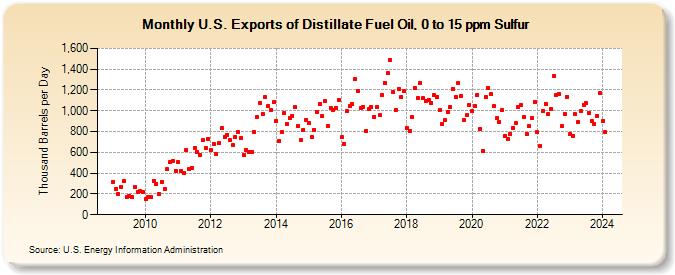
Be carefuel not to use the numbers lumping all distillates together.
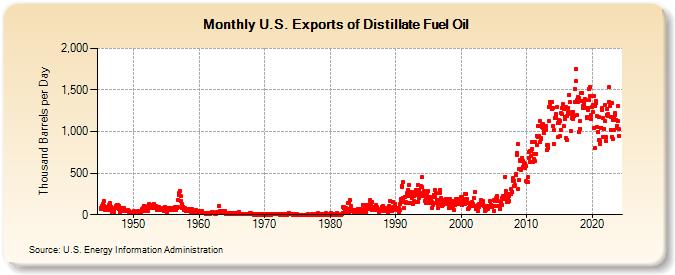
The residual fuel oil and petroleum coke remain significant numbers in the export.
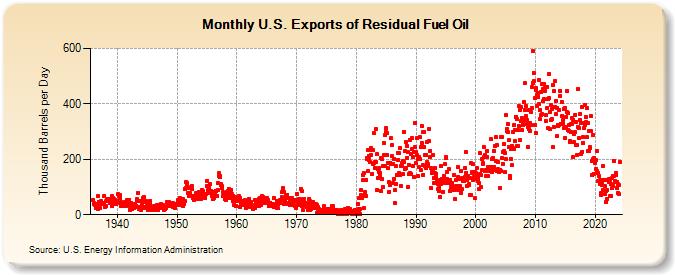
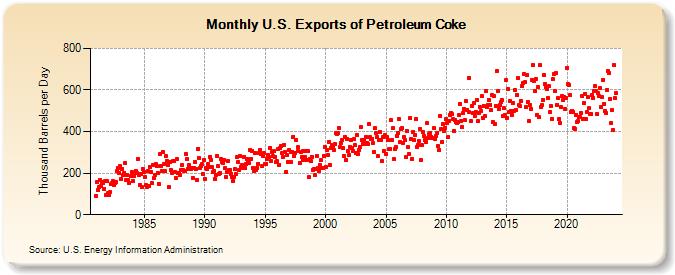
Also our increases in capacity combined with lower demand has lead to more gasoline exports.
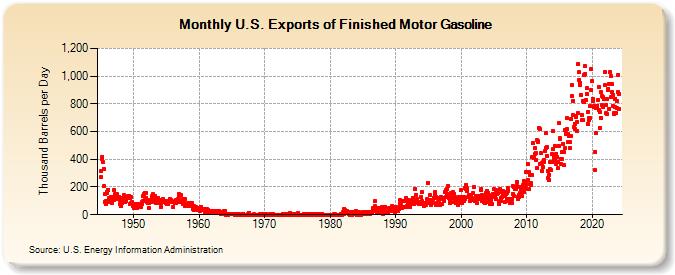
Source: Petroleum Exports
http://www.eia.gov/dnav/pet/pet_move_exp_dc_NUS-Z00_mbblpd_m.htm
It appears most of our exports goes to Mexico and Canada rather than Europe, but a significant amount to the Netherlands.
Exports by destination:
http://www.eia.gov/dnav/pet/pet_move_expc_a_EP00_EEX_mbblpd_m.htm
It is true we have become a net exporter of products, making more that we use.
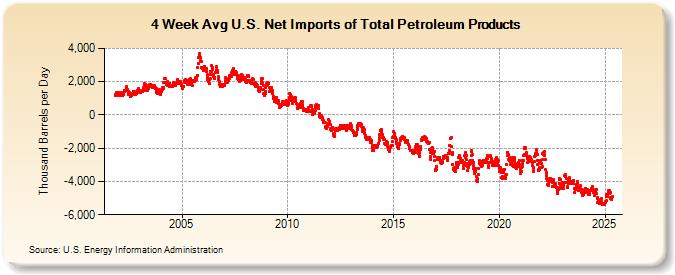
At the same time, we have seen a recent upswing in our total distillate products sold in the US.
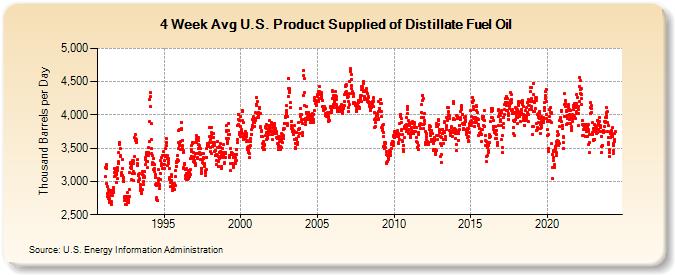
Our ULSD consumption is up, but not greatly up as of the last data (Aug)>
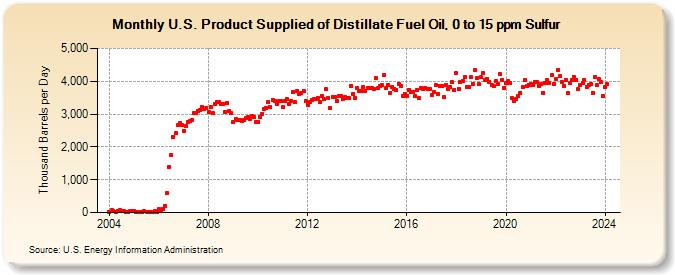
All that taken together, I'm sure the demand in Europe puts pressure on the ULSD pricing, but I don't see Europe alone create the price differential. We have had that export demand for a while. We are doing some of that ourselves with increased demand at this time.
17
posted on
11/29/2011 8:38:24 AM PST
by
thackney
(life is fragile, handle with prayer)
To: Paladin2
Petroleum products are sold in an international market, something that the people arguing that increasing US production will substantially bring down domestic prices tend to forget.
To: Eric in the Ozarks
19
posted on
11/29/2011 8:41:03 AM PST
by
meatloaf
(I've had it with recycling politicians in any way shape or form. Toss 'em out!)
To: NVDave
“Once we went to ULSD, our diesel became a viable import fuel in Europe. As long as our #2 was upwards of 500 ppm sulphur, it couldn’t be exported to Europe.
Another “win” brought to us by the environmentalists.
I won’t even mention the costs of dealing with ULSD and old rotary fuel pumps that depended on high sulphur content for lubricity.”
A number of states are now mandating ULSD for home heating oil now. My state of NY is starting this in Jan. 2012. The plus is that oil fired equipment will run cleaner and will now be viable for condensing operation without the corrosion issues of higher sulfur fuel. The minus may be the increased fuel cost.
20
posted on
11/29/2011 8:58:58 AM PST
by
headstamp 2
(Time to move forward not to the center.)
Navigation: use the links below to view more comments.
first 1-20, 21-22 next last
Disclaimer:
Opinions posted on Free Republic are those of the individual
posters and do not necessarily represent the opinion of Free Republic or its
management. All materials posted herein are protected by copyright law and the
exemption for fair use of copyrighted works.
FreeRepublic.com is powered by software copyright 2000-2008 John Robinson







